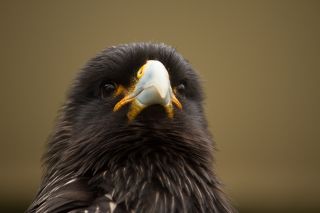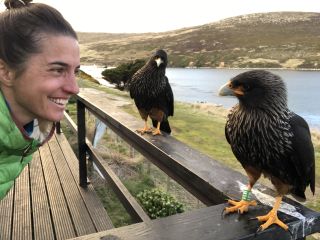Animal Behavior
Meet the Falcons That Act Like Parrots
Striated caracaras are enthusiastic and curious problem-solvers.
Posted November 20, 2023 Reviewed by Devon Frye
Key points
- Striated caracaras are unusual birds of prey in the south Atlantic known for their curiosity and playfulness.
- Researchers presented wild caracaras with a puzzle box containing eight different food challenges.
- Caracaras demonstrated rapid, flexible learning and innovation on par with tool-using parrots.

At the southern tip of South America lives a quirky and curious bird of prey unlike any other. Striated caracaras are in the falcon family, but they don’t behave anything like other falcons, says cognitive ecologist Katie Harrington.
“You come across a caracara and they’re social and they run across the ground and they peck at your backpack. They play with random objects. They are constantly exploring things in their environment,” she says. “They just have this energetic, inquisitive approach to life that you don’t see in other birds of prey.”
Since 2016, Harrington has traveled to the Falkland Islands twice a year to study striated caracaras, or Johnny rooks as they are known locally. Now a Ph.D. student at the Messerli Research Institute in Vienna, she leads the Johnny Rook Project, an international conservation research program focused on monitoring and understanding these birds.

While striated caracaras may not act like other falcons, their behavior did remind Harrington of another bird: the kea, a parrot native to New Zealand and known for its curiosity and intelligence. It might seem like an unlikely comparison at first, but recent genetic analyses show that falcons, including the caracara, are actually more closely related to parrots and songbirds than to hawks and eagles.
In addition to being cousins, kea parrots and caracaras face many of the same ecological pressures, including harsh environments with variable and unpredictable resources—the type of conditions that favor behavioral flexibility. However, caracaras are much less studied than kea. How would they perform on a test of problem-solving and innovation?
Brainy Birds
Harrington and colleagues created a puzzle box containing eight problem-solving tasks to present to wild caracaras. They adapted their design from a box created to test captive Goffin’s cockatoos, an intelligent and tool-using parrot. Each of the food-rewarded tasks required some behavior that the caracaras could produce but had to apply in a novel way. Harrington lugged the box to the Falkland Islands, to a long-term monitoring site where caracaras have been ringed (individually marked) biannually since 2010.

“We had no idea what to expect,” says Harrington. “Yes, caracaras will be there. Yes, they love new objects. Yes, they are unafraid of humans. Yes, they like to get up in everything, but will they engage with the box?”
It turns out, Harrington had nothing to worry about: “Almost immediately after I sat the box down, the birds started exploring it and problem-solving,” she says.
The striated caracaras repeatedly innovated new solutions to the tasks. Over time, they performed faster and found an increasing number of solutions, demonstrating learning. “Some birds were even running towards the box as soon as it became available,” says Harrington. “You just don’t think about this kind of behavior from a bird of prey.” (Watch videos of puzzle-solving caracaras here.)
The caracaras performed comparably to Goffin’s cockatoos who faced the same tasks in a previous laboratory study. They were even able to solve a few tasks that stumped some of the cockatoos.
Conserving Caracaras
Harrington and colleagues attribute the caracaras’ impressive performance to their ecology. The population on the Falklands is isolated and surrounded by ocean and high winds. Resources, including when and where they will find their next meal, are unpredictable. Striated caracaras must have a flexible mindset and be on the lookout for opportunities to deal with these challenges.
“They are constantly probing and exploring,” says Harrington. “They are like little scientists, walking around and testing their environment all day long.”

Harrington says that research like this is essential to better understand and draw attention to this remarkable bird. Globally, there are estimated to be fewer than 2,500 adult striated caracaras. The population on the Falklands is especially vulnerable; potential threats such as sea level rise, wildfires, and avian flu could have devastating consequences.
The mission of the Johnny Rook Project is to learn more about these birds in order to protect and conserve them. The results of this study demonstrate that wild caracaras make eager research participants, opening up exciting possibilities for future projects investigating curiosity, exploration, learning, problem-solving, and play in this species.
“Now that we have these initial results, the sky is the limit,” says Harrington.
References
Harrington, K.J., Folkertsma, R., Auersperg, A.M.I., Biondi, L., and Lambert, M.L. (2023) Innovative problem solving by wild falcons. Current Biology. 33 (24). 10.1016/j.cub.2023.10.061.




